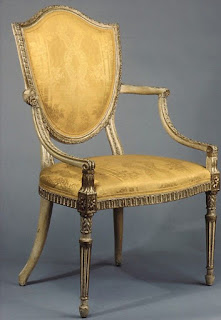Being unable to find any facts about the sources of the chintz quilts we've been looking at closely for several years, I have come up with a fiction.
Historical fiction. The tale:
Reasonable approximation of Miss Black and Mr. Green
before their marriage
Twenty-year-old Jane Black is making a good marriage in South Carolina in 1835. Her intended is heir to an enormous lowcountry plantation empire---thousands of acres of rice and cotton, hundreds of slaves to farm it and a beautiful if isolated country home called Oulde Scotland in the backwaters just a little west of the Atlantic sea islands.
Currier & Ives approximation of Oulde Scotland
Human property makes the Green family one of the richest in the U.S.
Their factor Mr. Brown
might look like this. Prosperous, reliable, honest.
Their factor or agent Mr. Brown does all their business. He sells their crops in England and loans them money to buy next year's seed and this year's household goods like sugar and coffee. He arranges to ship the manufactured goods up river to the plantation and to ship the crops out.
Mr. Brown has recently purchased a set of Sevres china for the Greens.
Mr. Brown does their shopping in Charleston and he has contacts in England and France for real luxury goods. He keeps accounts with little actual money changing hands. Annual cotton sales pay for a year's worth of shopping. If the cotton fails, he keeps his planters afloat for a year until the next crop. Thus the Greens are not affected by weather or market ups and downs unless year follows year of poor weather or political instability.
Mr. Brown has recently purchased an up-scale house like the one on the left in
the city. Although not really Carolina aristocracy he lives like it.
Mr. Brown, of course, keeps a percentage of transactions for himself.
Mrs. Green's neighbor has purchased two quilts similar
to this for her daughters.
Mr. Green writes Mr. Brown that his wife would like to buy an elegant chintz bedcover for her new daughter in law. Engagements are often short but there is enough time before the wedding that the enslaved needlewomen (the "servants") can get it quilted if it is promptly delivered. Mr. Brown often deals with requests like this as chintz bedcovers are quite the fashion in Georgia and the Carolinas among the elite. He knows just whom to contact.
Mrs. Lavender runs a high-end sewing business in Charleston. She herself is a free-black woman (an F.P.C.---free person of color as the census would show). She employs many free black seamstresses to sew household goods for the wealthy. Several of her seamstresses are enslaved but have been hired to work out in her sewing room with their wages going to their owners, of course. She also has a few Irish immigrants who do good work. And several widowed Charleston matrons do handwork for her at home but few people know that these down-on-their-luck aristocrats are forced to earn money.
Charleston was a major port and a major retail center
Mrs. Lavender is a good designer, an excellent needlewoman and a careful supervisor, well known for her drapes, chair covers and bedcovers.
She is also quite frugal and often buys fabric directly from ship owners who import English chintzes in quantity. The regular captains know she is a good customer for high-quality cotton florals and stripes. She is known never to waste a square inch of the imported cottons or silks.
Mrs. Lavender tells Mr. Brown she has just the thing for the Greens. She's recently purchased a good stock of chintz with fruit baskets and stripes to match.
All the Charleston society ladies have been ordering bedcovers featuring these large fruit baskets or similar chintzes. Give her a few days and she will have her girls stitch a large top.
Mrs. Green is thrilled to have her order delivered so quickly and she sets Lucy and Dorcas, her most talented servants to work at quilting the top in a simple grid design.
Saida might have time to help quilt when the
baby is asleep
Mrs. Lavender might design something like this,
not a lot of applique work, incorporating small scraps from other
projects. Stripes are quite the fashion as in the borders. Her sewing girls
can get it finished in a few days.
Jane loves the bedquilt and saves it for best. As her daughters grow up they learn to respect it too and when their mother dies after her eighth childbirth, the children put it away. The eldest, another Jane, gives it to her own daughter telling her the story of how her sainted mother stitched the quilt with her own hands when she was a young bride.
"She was an excellent needlewoman but this is the only piece
of her work that's been handed down. Treasure it always."
As we often say around here:
"That's my story and I'm sticking to it."



















You nailed it! It’s an excellent story that could indeed be the real deal. 💝
ReplyDeletePerfectly plausible!
ReplyDeleteI am way behind on my blog reading this month! Great story! And, if you get an agent maybe they will pick up on this and start teaching it in schools as gospel!
ReplyDelete